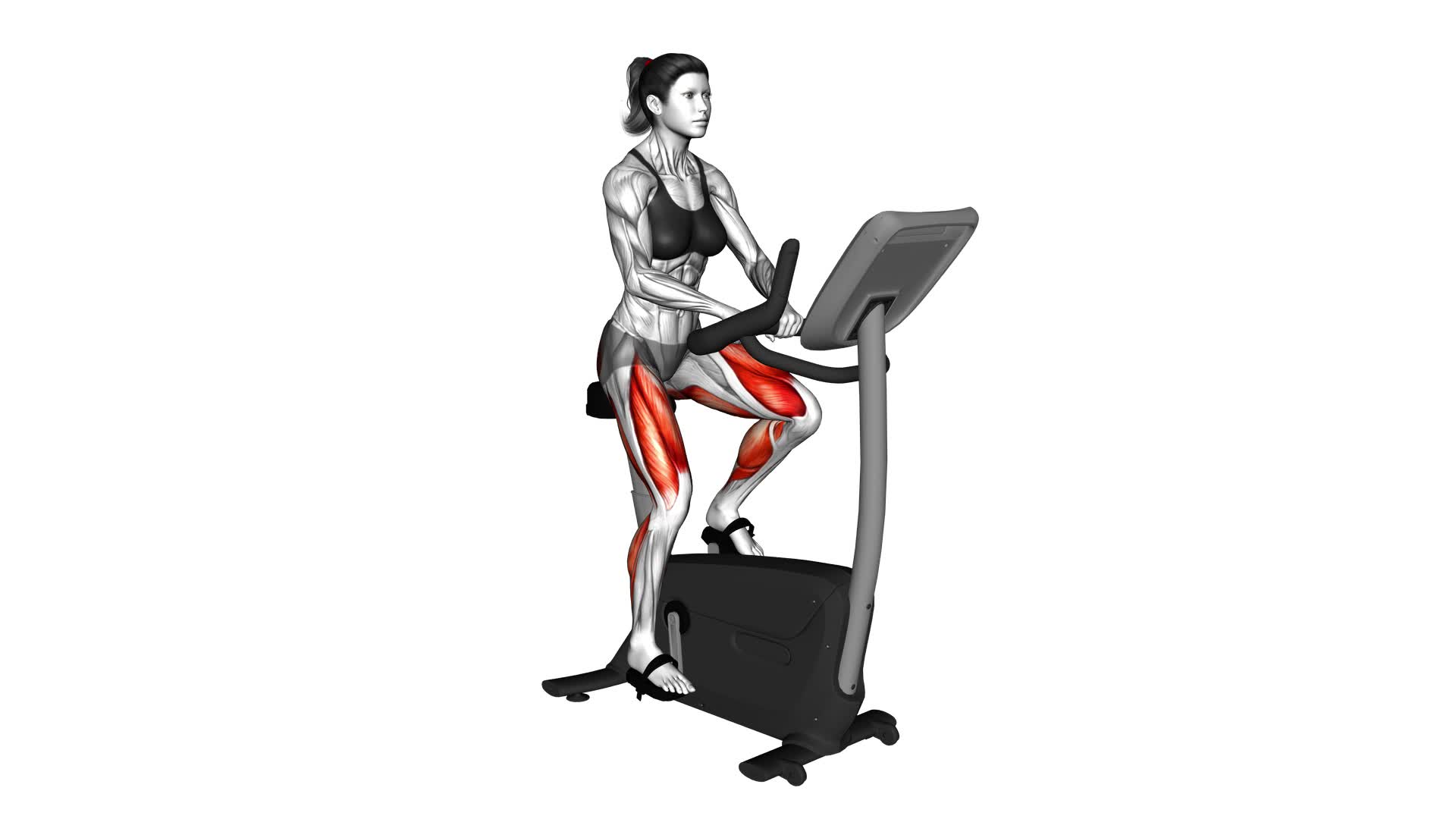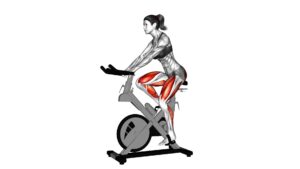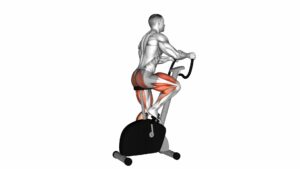Stationary Bike Run (version 4) (female) – Video Exercise Guide & Tips

Are you ready to take your stationary bike workouts to the next level?
Watch This Exercise Video
In this video exercise guide, we'll show you how to properly set up your bike, warm up and stretch, and perform high-intensity interval training (HIIT) workouts.
You'll also learn effective techniques for resistance training and discover cool-down and recovery strategies.
Get ready to sweat and see results with this female-focused stationary bike run.
Let's pedal our way to fitness together!
Key Takeaways
- Proper bike setup is crucial for an effective and comfortable workout, including adjusting seat height and handlebars
- Warm-up and stretching routines before the bike run help improve flexibility and prevent muscle strain
- High-Intensity Interval Training (HIIT) workouts on the stationary bike can improve cardiovascular fitness and burn calories effectively
- Resistance training techniques, such as using resistance bands and incorporating hill climbs and interval sprints, can enhance cardiovascular fitness and build strength
Proper Bike Setup
Set up your stationary bike properly to ensure an effective workout. Proper bike fit is essential to prevent discomfort and injury during your exercise session.
Adjust the seat height so that your legs are almost fully extended when the pedals are at the lowest position. This will allow for proper pedal stroke techniques and maximize your power output. Ensure that your knee is slightly bent when the pedal is at its lowest point to avoid strain.
Adjust the seat forward or backward to find a position where your knees are directly aligned with your toes when your feet are on the pedals. This alignment promotes efficient power transfer and reduces the risk of knee pain.
Additionally, make sure the handlebars are at a comfortable height and distance from your body, allowing for a relaxed and natural posture.
Once your bike is set up correctly, you can move on to the next step of your workout, which is the warm-up and stretching routine.
Warm-up and Stretching Routine
Prepare your body for the workout ahead with a dynamic warm-up and stretching routine. Warming up before exercising helps increase blood flow to your muscles, preparing them for the upcoming workout and reducing the risk of injury.
Start with some light cardio exercises such as jogging in place or jumping jacks to get your heart rate up and your muscles warmed up. After about five minutes of cardio, move on to stretching exercises to improve flexibility and prevent muscle strain.
Include warm-up exercises that target the specific muscles you'll be using during your stationary bike run. For example, you can perform leg swings to loosen up your hip flexors and hamstrings. Stand next to a wall or a sturdy object for support, then swing one leg forward and backward, gradually increasing the range of motion. Repeat this exercise for about 10 swings on each leg.
To further prepare your body, incorporate stretching techniques such as calf stretches and quad stretches. Stand facing a wall, place your hands on the wall for support, and step one foot back, keeping both heels on the ground. Lean forward, feeling the stretch in your calf muscle. Hold for 20-30 seconds and then switch legs. For quad stretches, stand tall and grab one foot behind you, pulling it towards your glutes. Hold for 20-30 seconds and then switch legs.
High-Intensity Interval Training (HIIT) Workouts
To maximize your workout and challenge your body, incorporate high-intensity interval training (HIIT) workouts into your stationary bike routine. HIIT involves alternating between short periods of intense exercise and brief recovery periods. This type of training has been proven to be highly effective in improving cardiovascular fitness and burning calories.
Interval timing is crucial in HIIT workouts. Start by setting a timer or using a workout app that allows you to customize your intervals. Begin with a warm-up period of moderate intensity for about 5 minutes. Then, increase the resistance and pedal at maximum effort for 20-30 seconds. Follow this with a 10-15 second recovery period of lower intensity. Repeat this cycle for a total of 10-15 intervals, depending on your fitness level and goals.
Heart rate monitoring is also important during HIIT workouts. Invest in a heart rate monitor or use the one available on your stationary bike. Aim to reach about 80-90% of your maximum heart rate during the intense intervals. This will help you gauge your effort level and ensure you're working at a high intensity. During the recovery periods, your heart rate should drop to around 50-60% of your maximum heart rate.
Remember to always listen to your body and adjust the intensity and duration of your intervals as needed. With consistent HIIT workouts on your stationary bike, you can expect to see improvements in your cardiovascular fitness and overall endurance.
Effective Techniques for Resistance Training
During your stationary bike workout, incorporate effective techniques for resistance training to maximize your strength and muscle-building potential. Resistance training is an essential component of any fitness routine, and when combined with your bike workout, it can take your fitness to the next level. Here are four effective techniques for resistance training that you can incorporate into your stationary bike routine:
- Resistance Band Exercises: Attach a resistance band to your bike and incorporate exercises like bicep curls, tricep extensions, and chest presses. This will target your upper body muscles and add an extra challenge to your workout.
- Hill Climbs: Increase the resistance on your bike and simulate climbing a hill. This will engage your leg muscles and help build strength and endurance.
- Interval Sprints: Alternate between high-intensity sprints and recovery periods. This won't only improve your cardiovascular fitness but also engage your leg muscles in a powerful way.
- Standing Pedals: Stand up on your bike and pedal, engaging your core and lower body muscles. This will challenge your balance and stability while building strength.
Incorporating these resistance training techniques into your stationary bike workout won't only enhance your cardiovascular fitness but also provide strength training benefits, helping you build lean muscle and increase overall strength.
Cool-down and Recovery Strategies
After completing your stationary bike workout incorporating effective resistance training techniques, it's essential to focus on cool-down and recovery strategies to optimize your post-exercise experience.
Cool-down techniques help gradually bring your heart rate back to its resting state and prevent blood pooling in your muscles. This can be achieved by slowly reducing the intensity of your biking for about 5-10 minutes. You can also incorporate stretches that target the muscles you worked during your workout. Stretching helps improve flexibility, reduces muscle soreness, and promotes muscle recovery.
To further enhance muscle recovery, consider incorporating foam rolling into your cool-down routine. Foam rolling is a self-myofascial release technique that helps alleviate muscle tightness and improve blood circulation. By targeting specific muscle groups with the foam roller, you can address any areas of tension or trigger points.
In addition to cool-down techniques, proper nutrition and hydration are crucial for muscle recovery. After your workout, make sure to consume a balanced meal or snack that includes protein to aid in muscle repair and carbohydrates to replenish glycogen stores. Hydrating with water or a sports drink will also help replace fluids lost during exercise.
Frequently Asked Questions
How Often Should I Clean and Maintain My Stationary Bike?
To keep your stationary bike in good working condition, it's important to clean and maintain it regularly. Cleaning frequency depends on how often you use the bike, but a general rule is to wipe it down after each workout and give it a deep clean every few weeks.
Remember to check the pedals, seat, and handlebars for any loose screws or bolts and tighten them if necessary. Regular maintenance will help prolong the lifespan of your bike and ensure a smooth and safe ride.
Can I Use a Stationary Bike if I Have Knee or Joint Problems?
If you have knee or joint problems, using a stationary bike can still be a great option for you. It's a low-impact exercise that puts less stress on your joints compared to running or other high-impact activities.
Using a stationary bike can help with weight loss by burning calories and increasing your cardiovascular endurance. It also has benefits for rehabilitation, as it can help improve joint mobility and strengthen the muscles around your knees and joints.
Is It Necessary to Wear Specific Shoes While Using a Stationary Bike?
It's not necessary to wear specific shoes while using a stationary bike. However, using clip-in shoes can offer some benefits. Clip-in shoes help to secure your feet to the pedals, providing better stability and power transfer during your workout.
If you don't have clip-in shoes, you can still have a great workout by wearing athletic shoes with a supportive sole. Just make sure your shoes fit well and are comfortable for your stationary bike workouts.
Are There Any Specific Exercises I Can Do to Target My Upper Body While Using a Stationary Bike?
While using a stationary bike, there are specific exercises you can do to target your upper body. Incorporating upper body workouts while biking can provide additional benefits. By engaging your arms and shoulders, you can increase muscle tone and strength in these areas.
Some exercises you can try are arm curls, overhead presses, and lateral raises. These exercises won't only work your upper body, but also add variety to your stationary bike routine.
Can I Use a Stationary Bike if I Have a Heart Condition or High Blood Pressure?
Yes, you can use a stationary bike if you have a heart condition or high blood pressure. It's a low-impact exercise that can be beneficial for cardiovascular health.
However, it's important to consult with your doctor before starting any exercise program, especially if you have a heart condition or high blood pressure. They can provide guidance on the intensity and duration of your workouts to ensure your safety and well-being.
Conclusion
In conclusion, the stationary bike run (version 4) offers a comprehensive workout routine for females.
With proper bike setup, a warm-up and stretching routine, high-intensity interval training workouts, effective resistance training techniques, and cool-down and recovery strategies, this exercise guide provides a complete fitness solution.
By following these tips and techniques, females can maximize their workout and achieve their fitness goals.

Author
Years ago, the spark of my life’s passion ignited in my mind the moment I stepped into the local gym for the first time. The inaugural bead of perspiration, the initial endeavor, the very first surge of endorphins, and a sense of pride that washed over me post-workout marked the beginning of my deep-seated interest in strength sports, fitness, and sports nutrition. This very curiosity blossomed rapidly into a profound fascination, propelling me to earn a Master’s degree in Physical Education from the Academy of Physical Education in Krakow, followed by a Sports Manager diploma from the Jagiellonian University. My journey of growth led me to gain more specialized qualifications, such as being a certified personal trainer with a focus on sports dietetics, a lifeguard, and an instructor for wellness and corrective gymnastics. Theoretical knowledge paired seamlessly with practical experience, reinforcing my belief that the transformation of individuals under my guidance was also a reflection of my personal growth. This belief holds true even today. Each day, I strive to push the boundaries and explore new realms. These realms gently elevate me to greater heights. The unique combination of passion for my field and the continuous quest for growth fuels my drive to break new ground.







